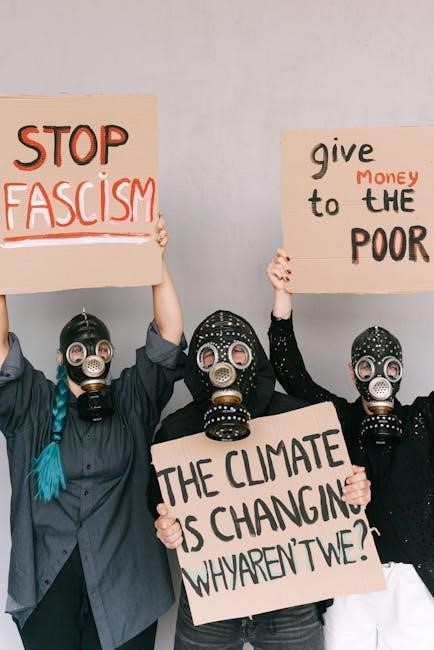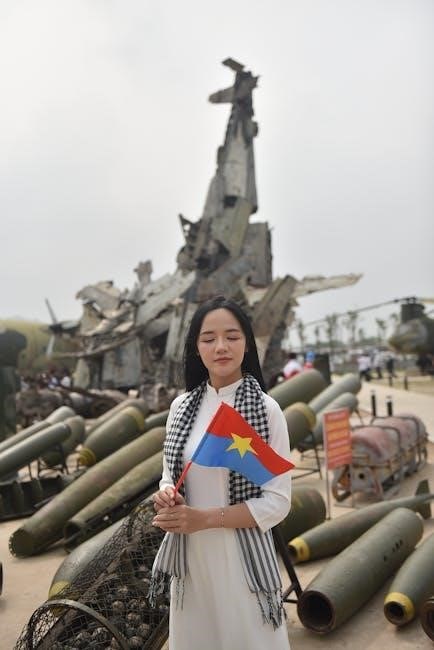The move to global war examines the escalation of conflicts from 1931 to 1941, focusing on Japanese, German, and Italian expansionism. It highlights how aggressive policies, nationalist ideologies, and economic instability led to World War II, shaping global history and diplomacy.
1.1. Historical Context of Global Conflict
The interwar period saw rising tensions fueled by the Treaty of Versailles, economic crises, and nationalist ideologies. Aggressive powers like Japan, Germany, and Italy sought expansion, exploiting weaknesses in the global order. The League of Nations’ failure to prevent aggression and the collapse of international cooperation set the stage for escalating conflicts, ultimately leading to the outbreak of World War II.
1.2. Importance of Understanding the Move to Global War
Understanding the move to global war is crucial for analyzing the origins of World War II and its profound impact on modern history. It reveals how political, economic, and ideological factors intertwined to create a volatile global environment. Studying this period offers insights into diplomacy, nationalism, and the consequences of aggressive expansion, helping to prevent similar conflicts in the future.
Causes of World War II
The Treaty of Versailles, rise of nationalism, militarism, and appeasement policies fueled aggressive expansion by Axis powers, leading to the outbreak of World War II.
2.1. The Treaty of Versailles and Its Impact
The Treaty of Versailles, signed in 1919, imposed harsh penalties on Germany, including heavy reparations and territorial losses, leading to economic hardship and widespread resentment. This created a fertile ground for extremist ideologies like Nazism to rise, as Hitler exploited the treaty’s terms to justify his aggressive foreign policy and territorial ambitions, setting the stage for future conflict.
2.2. Rise of Nationalism and Militarism
Nationalist sentiments surged in interwar Europe and Asia, with leaders like Hitler, Mussolini, and Tojo promoting aggressive expansion to restore national pride and secure resources. Militarism fueled these ambitions, as nations prioritized military buildup over diplomacy, creating an environment where conflict became inevitable and global war loomed, driven by competing imperialist and ideological goals.
2.3. Appeasement Policy and Its Consequences
Britain and France adopted an appeasement policy, giving in to Germany’s demands to avoid war. This emboldened Hitler, who annexed Austria and invaded Czechoslovakia. The Munich Agreement (1938) exemplified this approach, but it only delayed conflict. Hitler’s aggression continued, leading to the invasion of Poland in 1939, which finally prompted Britain and France to declare war, marking the start of World War II.

Japanese Expansionism (1931-1941)
Japanese expansionism from 1931 to 1941 involved the invasion of Manchuria, Second Sino-Japanese War, and Pearl Harbor attack, driven by resource needs and regional dominance ambitions.
3.1. Invasion of Manchuria (1931)
The Japanese invasion of Manchuria in 1931 marked the beginning of its aggressive expansion. Using the Mukden Incident as a pretext, Japan sought resources and strategic control. The League of Nations failed to intervene effectively, emboldening further Japanese aggression in Asia, setting the stage for broader regional conflict and eventual global war.
3.2. The Second Sino-Japanese War (1937-1945)
The Second Sino-Japanese War began with the Marco Polo Bridge Incident in 1937, escalating into full-scale conflict. Japan sought to dominate China, capturing key cities like Shanghai and Nanjing. The war intensified regional tensions and drew global attention, contributing to the outbreak of World War II as Japan’s expansionist ambitions clashed with Western interests in Asia.
3.3. The Attack on Pearl Harbor (1941)
The Attack on Pearl Harbor occurred on December 7, 1941, as Japan launched a surprise assault on the U.S. naval base in Hawaii. This strategic move aimed to weaken American Pacific forces, enabling Japanese expansion. The attack led to the United States’ entry into World War II, transforming the conflict into a truly global war and shifting the balance of power in the Pacific.

German and Italian Expansionism (1933-1940)
Germany under Hitler pursued aggressive territorial expansion, violating the Treaty of Versailles, while Italy, led by Mussolini, sought colonial dominance in Africa, fostering an alliance that destabilized Europe.
4.1. Hitler’s Foreign Policy and Territorial Ambitions
Hitler’s foreign policy centered on reversing the Treaty of Versailles, expanding Lebensraum, and establishing German dominance. He pursued aggressive territorial claims, annexing Austria and invading Czechoslovakia, while promoting militarism and racial ideology to justify expansion, destabilizing Europe and setting the stage for World War II.
4.2. Mussolini’s Imperialist Dreams in Africa
Mussolini’s imperialist ambitions in Africa aimed to establish Italy as a colonial power. He invaded Ethiopia in 1935, using modern weaponry and propaganda to justify the conquest. This move sought to secure resources, expand territorial control, and avenge past defeats, showcasing fascist ideology’s aggressive expansionism and disregard for international norms, contributing to global tensions.
4.3. The Axis Alliance and Its Significance
The Axis Alliance between Germany, Italy, and Japan solidified their joint pursuit of territorial expansion and dominance. Formed in 1940, it coordinated military strategies and resource sharing, countering Allied forces. The alliance facilitated cooperation in key theatres, enhancing their collective strength and ambition, while deepening global divisions that escalated World War II’s intensity and reach, shaping its outcome.
Key Events Leading to Global War
The 1930s-1940s saw aggressive actions by Germany, Italy, and Japan, triggering a chain reaction of global conflict, escalating tensions, and ultimately leading to World War II.
5.1. The Invasion of Poland (1939)
Germany’s invasion of Poland on September 1, 1939, marked the beginning of World War II. Hitler’s forces used blitzkrieg tactics, quickly overwhelming Polish defenses. This act of aggression prompted Britain and France to declare war on Germany, escalating the conflict into a global crisis. The invasion violated the Treaty of Versailles and exposed the failures of appeasement, leading to the formation of alliances that shaped the war’s trajectory.
5.2. The Battle of Britain (1940)
The Battle of Britain, fought from July to October 1940, was a pivotal air campaign where the Royal Air Force (RAF) repelled the German Luftwaffe’s attempts to gain air superiority. This decisive victory prevented a German invasion of Britain, marking a significant turning point in World War II. It showcased the importance of air power and boosted British morale during a critical phase of the war.
5.3. Operation Barbarossa (1941)
Operation Barbarossa, launched on June 22, 1941, was Nazi Germany’s invasion of the Soviet Union, violating the Nazi-Soviet Pact. It opened the Eastern Front, one of World War II’s largest and bloodiest theaters. The invasion aimed to capture Soviet resources and territory but faced fierce resistance. Despite initial German advancements, the Soviets’ resilience marked a turning point, significantly impacting the war’s outcome and global conflict dynamics.

The Impact of Global War on World Development
The global war led to economic devastation, prompting rebuilding efforts and societal shifts, while politically, it spurred the formation of the United Nations and the Cold War era.
6.1. Economic Consequences of the War
The global war caused widespread economic devastation, with industries destroyed and trade disrupted. Many nations faced severe inflation, unemployment, and resource shortages. The conflict accelerated industrialization in some regions while crippling others. Post-war reconstruction efforts spurred economic growth, but the costs of rebuilding burdened economies for decades. The war also reshaped global economic hierarchies, as some nations emerged stronger while others struggled to recover.
6.2. Social and Political Changes Post-War
The war led to significant social and political shifts, including the decline of colonial empires and the rise of independence movements. The emergence of the Cold War reshaped global alliances, while the formation of the United Nations aimed to foster international cooperation. Societies grappled with the trauma of war, leading to reforms in healthcare, education, and human rights. Power dynamics shifted irrevocably, reshaping the modern world order.
6.3. The Emergence of the Cold War
The end of World War II ushered in the Cold War, a decades-long ideological and geopolitical conflict between the United States and the Soviet Union. The power vacuum left by devastated nations allowed these superpowers to rise, leading to tensions over communism versus capitalism. The arms race, proxy wars, and the Iron Curtain defined this era, reshaping global alliances and international relations indefinitely.
The Role of the United Nations in Preventing Future Wars
Established after World War II, the United Nations aimed to maintain global peace and security through diplomacy and cooperation, preventing future conflicts by addressing root causes of war.
7.1. Establishment and Aims of the UN
The United Nations was founded in 1945 to promote peace, security, and cooperation among nations. Its primary aims include preventing future wars, fostering dialogue, and addressing global challenges through collective action, ensuring a framework for international diplomacy and conflict resolution.
7.2. Challenges in Maintaining Global Peace
Maintaining global peace is hindered by ongoing conflicts, political tensions, and economic disparities. The UN faces challenges such as veto powers in the Security Council, funding shortages, and resource limitations. These obstacles often hinder effective intervention, making it difficult to address crises and promote lasting stability worldwide.
7.3. Relevance of the UN in the Modern World
The United Nations remains crucial for addressing modern challenges, fostering global cooperation, and promoting peace. Its role in conflict resolution, humanitarian aid, and sustainable development underscores its importance; Despite limitations, the UN provides a platform for dialogue and collective action, making it indispensable in addressing contemporary issues like climate change, human rights, and security threats.
The move to global war highlights lessons from aggressive nationalism and diplomatic failures, emphasizing the importance of international cooperation to prevent future conflicts and foster peace.
8.1. Lessons Learned from the Move to Global War
The move to global war underscores the dangers of aggressive nationalism, militarism, and appeasement. It highlights the importance of diplomacy, collective security, and international cooperation to prevent future conflicts. The devastating consequences of war also emphasize the need for peaceful resolution of disputes and the promotion of global stability to avoid similar tragedies.
8.2. The Importance of Diplomacy and Cooperation
Diplomacy and cooperation are vital in preventing global conflicts. The failure of the League of Nations and the policy of appeasement highlight the need for stronger international institutions. Collective security mechanisms and open dialogue can prevent escalation, while collaboration fosters trust and stability. Lessons from global war emphasize that unity and cooperation are essential for maintaining peace and avoiding future catastrophes.
Bibliography
- The Move to Global War by Joanna Thomas and Keely Rogers.
- Access to History for the IB Diploma by Russell Quinlan.
- Hodder The Move to Global War study guides and resources.
9.1; Key Historical Sources
Key historical sources include The Move to Global War by Joanna Thomas and Keely Rogers, Access to History for the IB Diploma by Russell Quinlan, and Hodder The Move to Global War study guides. These resources provide comprehensive insights into military expansion, political ideologies, and global conflicts, offering a detailed understanding of the events leading to World War II.
9.2. Recommended Reading for Further Study
For deeper analysis, consider “The Move to Global War” by Joanna Thomas, “Access to History” by Russell Quinlan, and “Hodder The Move to Global War”. These texts provide detailed case studies on Japanese, German, and Italian expansionism, offering insights into political ideologies and military strategies that shaped the global conflict, aiding students in understanding historical complexities and exam preparation.

FAQs
Frequently Asked Questions address common inquiries about the move to global war, clarifying key events, causes, and impacts, while dispelling misconceptions for better understanding.
10.1. Common Questions About the Move to Global War
What were the primary causes of World War II? How did Japanese expansionism differ from German and Italian strategies? What role did appeasement play? These questions explore key aspects of the global conflict, providing insight into the complex factors that led to war and its profound impact on world history and international relations.
10.2. Clarifying Misconceptions
A common misconception is that World War II was solely caused by Hitler’s aggression. However, factors like the Treaty of Versailles, economic instability, and appeasement policies also played crucial roles. Additionally, many believe that Japan’s expansion was solely driven by militarism, but economic needs and strategic interests were equally significant, highlighting the complexity of global conflicts and their multifaceted origins.